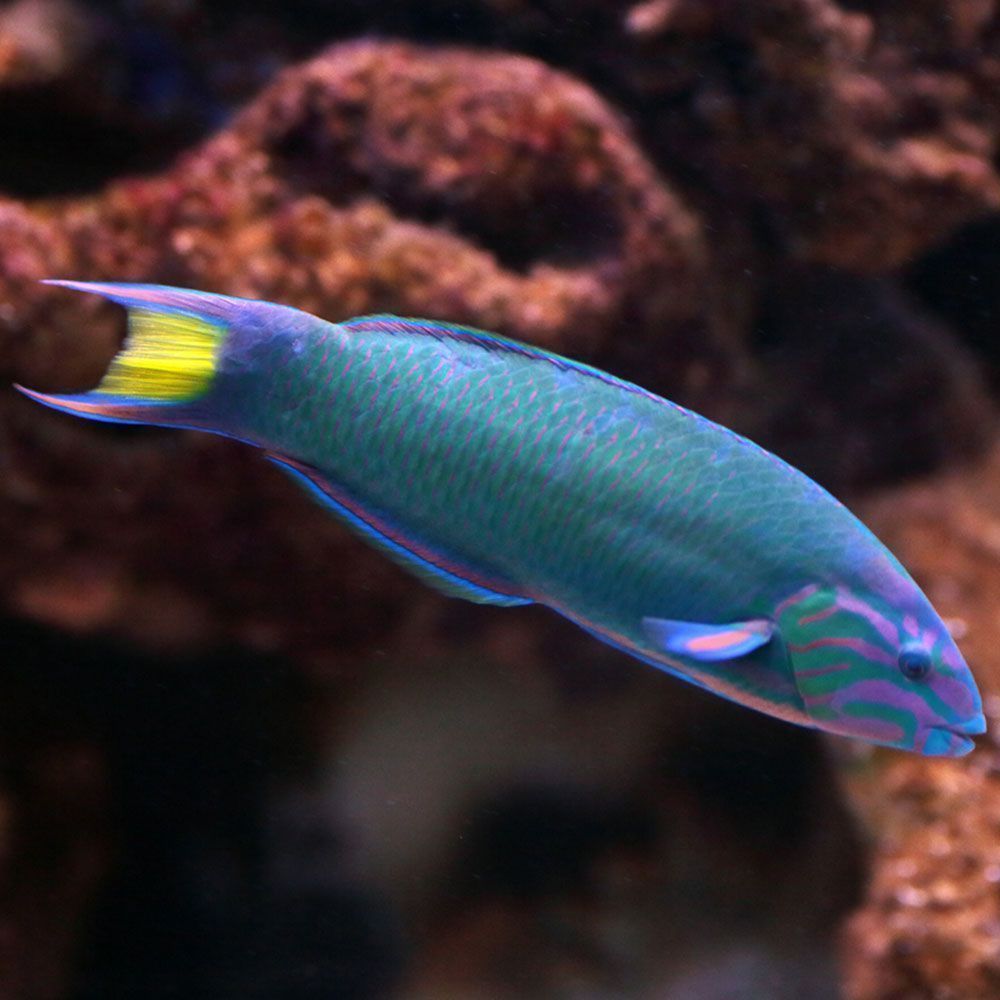If you want to add some eye-catching fish to your saltwater tank, there can be no better choice than wrasse fish species.
Wrasse fish are popular not only for their wide range of colors but also for their distinct personalities. Peaceful, aggressive, dominant… you name it, and there’s a wrasse of every type!
The active species is full of moderately-sized fish that will keep you hooked to your aquarium.
So, if you are trying to add a little red, green, or yellow wrasse dash to your tanks, you are about to get enlightened!
What is the History of Wrasse Fish?
The wrasse species comes from the Labridae family and Labriformes order. The wrasse family houses more than 600 species belonging to 21 genera and 9 subgroups/tribes.
The term “wrasse” is derived from the Cornish word ‘wragh’ meaning old woman. These fish are mainly known for their bright hues, patterns, and unique body shapes.
While most of the species are relatively small, the largest recorded wrasse species is the humphead wrasse. It measures to be around 90 inches (2.5 m) long.
These carnivores are also known to have protractile mouths that protrude outwards. Not all, but many of these species are protogynous hermaphrodites, i.e., born male and later turns into female. For some, the opposite is also possible.
Most of these species are inhabitants of tropical and subtropical zones of the Indian, Pacific, and Atlantic Oceans. These fish love to explore the entire tank, but they mostly prefer to dwell at the bottom.
What are the types of Wrasse Fish?
This list will walk you through the 12 of our personal favorites that most aquarists can’t stop raving about. Read on to spot your next wrasse buddy!
1. Melanurus Wrasse (Halichoeres melanurus)
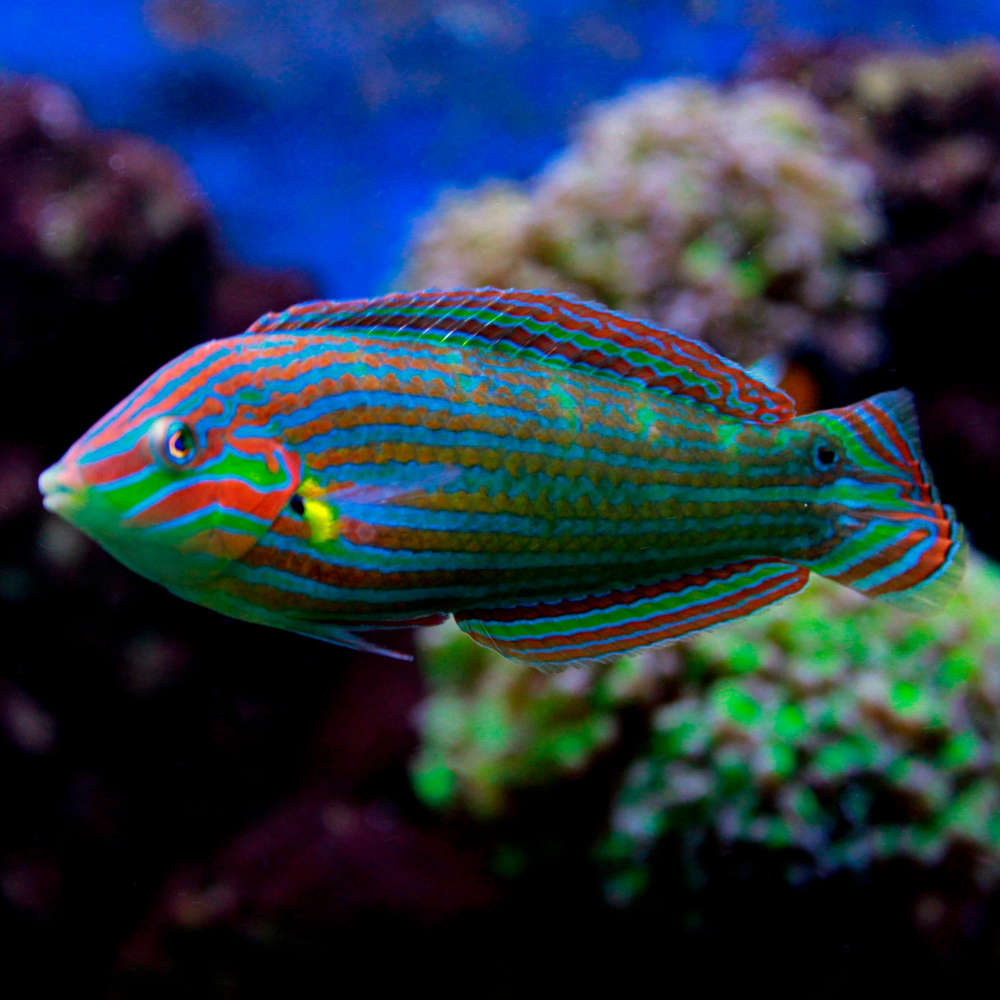
- Common Names: Yellow-tailed wrasse, three-eyed wrasse, tailspot wrasse, pinstriped wrasse, Hoeven’s wrasse
- Average Size: Up to 12.7 cm (5 in)
- Average Lifespan: Around 4-10 years
- Tank Level: Bottom dwellers
- Temperament: Peaceful yet predatory; Can display bullying behavior
- Diet: Carnivorous
- Reef Safe: Yes, with caution
- Tank Mates: Own harem, peaceful species
- Minimum Tank Size: 55 gallons
The melanurus wrasse possesses a distinctive torpedo-shaped body with a mesmerizing combination of turquoise-blue and green hues.
It features prominent horizontal stripes, resembling a maze, extending from head to tail.
This color palette is similar to other wrasse species, like the six and four-lined wrasses, but with a unique vibrancy that allows it to stand out against any reef backdrop.
It’s a sequential or protogynous hermaphrodite. So, it is born female and changes its sex when there are no other males or one female establishes dominance.
While females have slightly subdued coloring and distinctive spots on their dorsal fin and tail, males display brighter and more vibrant color patterns.
The male fish gracefully glides through the water, resembling eels, and are truly captivating.
2. Six Line Wrasse (Pseudocheilinus hexataenia)
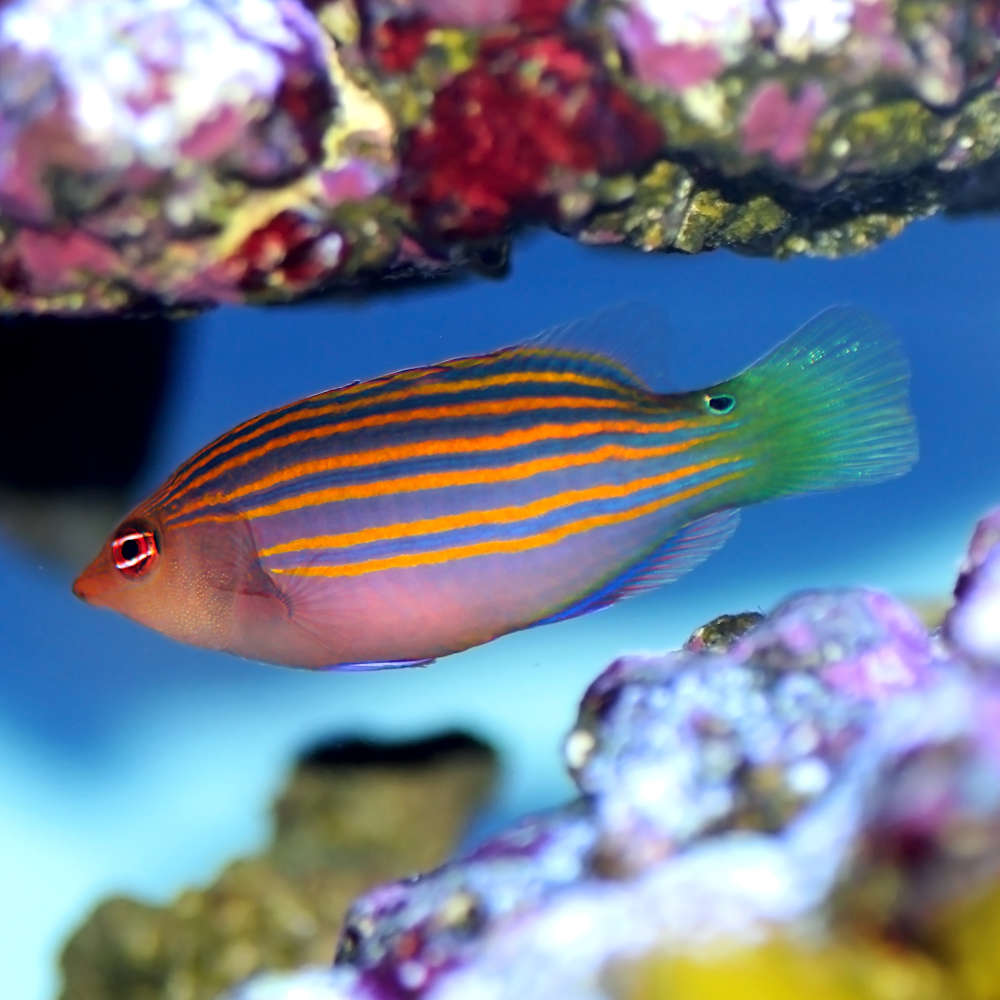
- Common Names: Sixstripe wrasse, six-lined wrasse, pyjama
- Average Size: Up to 10 cm (3.9 in)
- Average Lifespan: Up to 4-6 years
- Tank Level: Mid-bottom dweller
- Temperament: Semi-aggressive
- Diet: Carnivorous
- Reef Safe: Yes
- Tank Mates: Semi-aggressive similar-sized and slightly larger species
- Minimum Tank Size: 30 gallons
The six-line wrasse is a slender, banana-shaped fish that features six distinctive horizontal stripes in shades of orange or red.
It exhibits various colors, including bluish-purple, pinkish, and lavender. Additionally, it has a green or blue tail, a small false eye spot near the base of the dorsal tail peduncle, and red eyes.
The male six-line wrasse tends to be larger than its female counterparts. As the spawning season approaches, the fish becomes even more vibrant.
The fish uses its eyespot as a deceptive feature to trick predators into attacking their rear. Then, the six-line wrasse makes a quick escape.
3. Leopard Wrasse (Macropharyngodon meleagris)

- Common Names: Vermiculated wrasse, reticulated wrasse, guinea fowl wrasse. Eastern leopard wrasse, black spotted wrasse
- Average Size: Up to 15 cm (5.9 in)
- Average Lifespan: Approx 5-10 years
- Tank Level: Bottom dwellers
- Temperament: Peaceful
- Diet: Carnivorous
- Reef Safe: Yes
- Tank Mates: Other peaceful species, corals, invertebrates
- Minimum Tank Size: 100 gallons
Leopard wrasse is a protogynous hermaphrodite, beginning life as a sexually undifferentiated juvenile. It slowly transitions to a fully functioning female and ultimately into a male.
The juvenile is white or light green and has several black spots.
Females display a predominantly white body adorned with irregular black or brown spots, often outlined in white to blue. It may also feature hints of yellow or tan on the fins.
Males, on the other hand, showcase vibrant shades of orange or red complemented by splashes of blues and greens.
They may also be larger and much more vividly colored than their female counterparts.
In the initial days, you might find your leopard wrasses buried in the sand. This is because they are trying to adjust their circadian rhythm to the day and night pattern of the tank.
4. Bluestreak Cleaner Wrasse (Labroides dimidiatus)
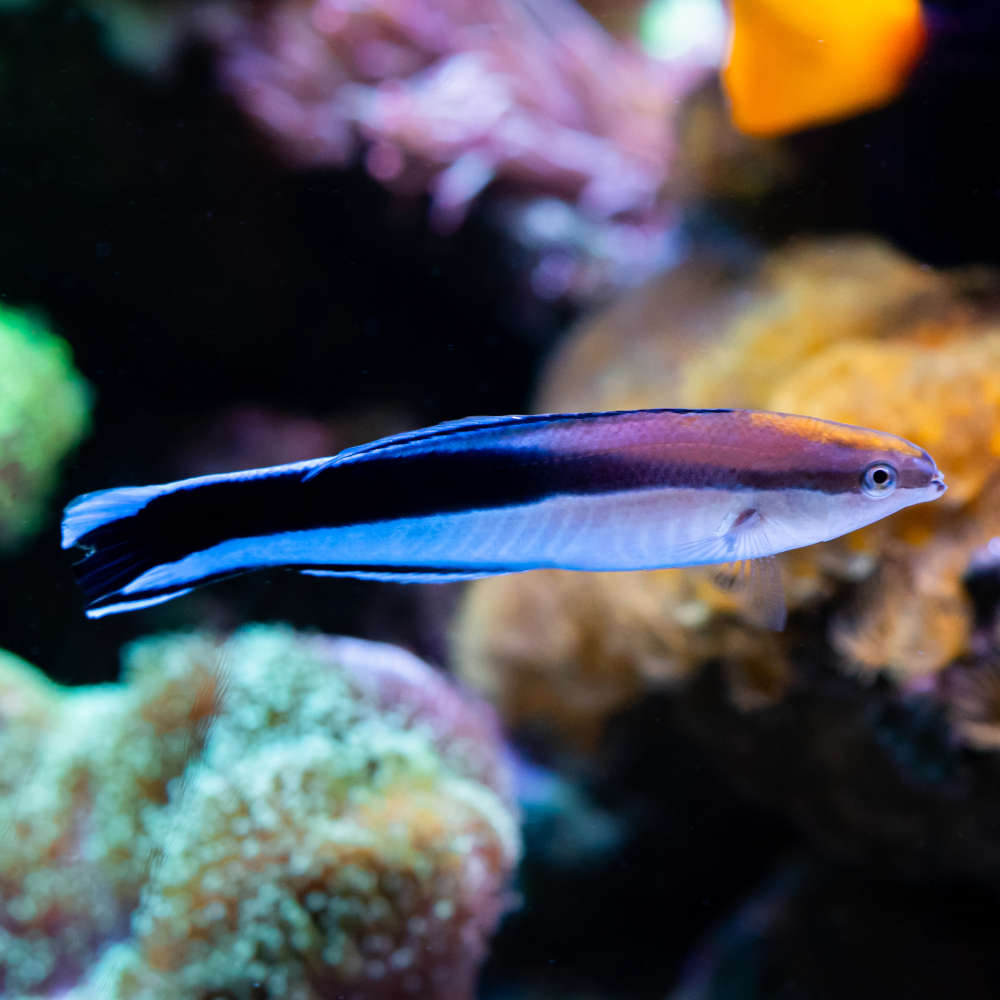
- Common Names: Gadfly fish, common cleaner fish, common cleaner wrasse, bridled beauty, bluestreak cleaner fish, blue streak, blue diesel wrasse
- Average Size: Up to 14 cm (5.5 in)
- Average Lifespan: Up to 4 years
- Tank Level: All levels
- Temperament: Peaceful
- Diet: Carnivorous
- Reef Safe: Yes
- Tank Mates: Own species, other peaceful and semi-aggressive species
- Minimum Tank Size: 75 gallons
The bluestreak cleaner wrasse is a small slim, elongated-bodied fish. This has a prominent black horizontal band separating its white underside from its predominantly blue upper half.
However, when found in deeper waters, the wrasse may exhibit a yellowish hue on their backs.
Distinguishing between male and female fish based on visual cues is nearly impossible. This is a hermaphroditic species, meaning it possesses both male and female reproductive organs.
You can only tell apart the two genders when they form pairs or harems. It’s because the male pairs with smaller specimens, helping you distinguish males and females better.
When grouped, these species can open their own ‘cleaning station’, meaning they can clean your tank for free. In the wild, they also offer cleaning services to other fish, removing parasites and debris from their bodies.
5. Dragon Wrasse (Novaculichthys taeniourus)

- Common Names: Rockmover wrasse, carpet wrasse, bar-cheeked wrasse, reindeer wrasse, olive-scribbled wrasse
- Average Size: Up to 30 cm (12 in)
- Average Lifespan: Up to 10-12 years
- Tank Level: Bottom dwellers
- Temperament: Aggressive
- Diet: Carnivorous
- Reef Safe: No
- Tank Mates: Other energetic and aggressive species
- Minimum Tank Size: 40 gallons
Distinguishing between male and female individuals of this species is quite challenging because both sexes share very similar appearances and are approximately the same size. Nonetheless, all stages of this species possess their own unique beauty.
The juvenile fish has horn-like appendages on the head, earning the name “Reindeer Wrasse.”
The flat-bodied fish comes in a spectrum of colors, including white, black, red, and deep green. The young wrasse sports long dorsal and pelvic fins characterized by dark rays and a transparent membrane, making it seem frilly.
However, among adult fish, the frilly nature of fins disappears. The body adopts a structured pattern of gray spots against a dark background, and the tail takes on a white coloration with a black border.
The dragon wrasse is known as the rockmover wrasse because of its habit of rearranging stones and shells.
6. Harlequin Tusk (Choerodon fasciatus)

- Common Names: Harlequin tuskfish
- Average Size: Up to 30 cm (12 in)
- Average Lifespan: Up to 8-10 years
- Tank Level: Middle to bottom dwellers
- Temperament: Semi-aggressive, shy as juveniles
- Diet: Carnivorous
- Reef Safe: No
- Tank Mates: Other semi-aggressive species
- Minimum Tank Size: 125 gallons
The harlequin tuskfish is known for its vibrant colors, like blue, green, and orange. It possesses distinctive sharp blue teeth.
The adult fish exhibits a striking pattern of copper-toned bands ranging from orange to silver to green, often separated by delicate blue stripes.
As it grows older, these bands become more pronounced and darker. The fins have a reddish hue with a blue stripe running along the edges.
The younger fish is not as vividly colored and may appear pale in comparison to mature adults. It also has black spots on fins, aka eyespots.
The species has notably large eyes that can move independently, allowing it to thoroughly assess the surroundings.
The fish is a protogynous hermaphrodite, i.e., born female and can transform into male. But the two genders are not visually differentiable.
The young fish uses eyespots to prevent potential predators from attacking its crucial parts.
7. Yellow Coris Wrasse (Halichoeres chrysus)

- Common Names: Yellow wrasse, yellow coris, golden wrasse, golden rainbow fish, canary wrasse
- Average Size: Up to 12 cm (4.7 in)
- Average Lifespan: Around 5-7 years in captivity; up to 10 years in the wild
- Tank Level: Middle to bottom dwellers
- Temperament: Docile, peaceful, aggressive toward own species
- Diet: Carnivorous
- Reef Safe: Yes, with caution
- Tank Mates: Other peaceful wrasses, other peaceful species
- Minimum Tank Size: 40-50 gallon
The yellow coris wrasse has a slim and elongated body shape with mouths positioned at the front, giving it a forward-facing terminal mouth structure. It possesses distinct dorsal, pectoral, anal, and caudal fins. The wrasse has vibrant golden-yellow skin.
Juveniles display two noticeable ‘eyespots’ on the dorsal fin and a smaller one at the base of the caudal fins. The spots gradually fade with age, leaving only a single eyespot on the dorsal fin. Further, a mature male fish develops greenish lines near the face.
It is a protogynous hermaphrodite and not sexually dimorphic. All individuals start as females and can switch to a male gender under specific conditions. Rarely, some are also born males, often called “super males”.
Males tend to be larger and exhibit more vivid body coloration compared to females.
They bury themselves in the sand while feeling threatened. It can also be a part of their nighttime routine.
8. Christmas Wrasse (Thalassoma trilobatum)
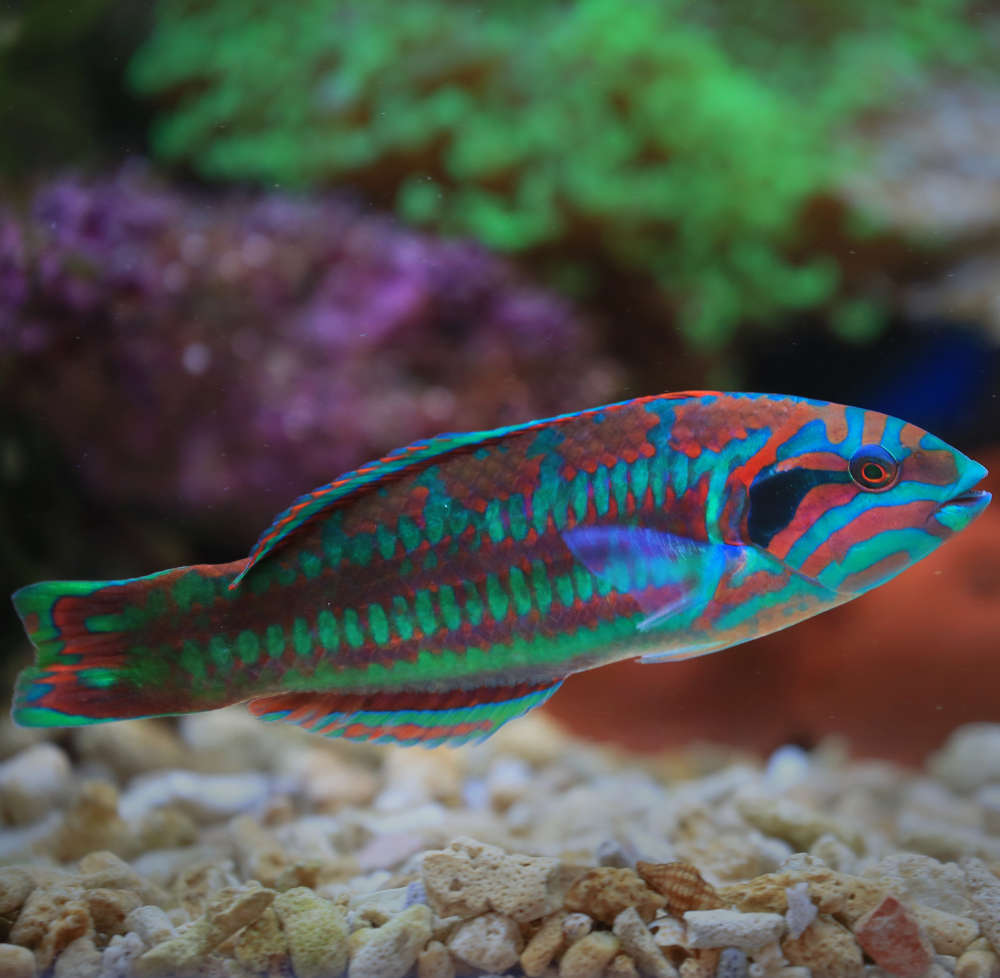
- Common Names: Parrot fish, ladder wrasse, lagger wrasse, green barred wrasse, green blocked wrasse
- Average Size: 30 cm (12 in)
- Average Lifespan: 4-10 years
- Tank Level: Bottom to middle dwellers
- Temperament: Peaceful
- Diet: Carnivorous
- Reef Safe: Yes
- Tank Mates: Own species, other peaceful fish
- Minimum Tank Size: 50 gallons
The Christmas wrasse fish is named after its vivid red and green hues signifying Christmas. It also displays a spectrum of other colors, such as red, pink, blue, and orange.
This slender, streamlined-bodied fish has horizontal red lines that extend from the back to the dorsal, caudal, and anal fins. It has a distinctive ladder-like patterned appearance.
It’s a sequential hermaphrodite, i.e., it begins life as a female, showcasing a pink-to-red background with greenish-blue stripes in a ladder-like pattern. Around the head, the coloration breaks into spots.
Due to the coloration variation between the two sexes and the less vibrant shades seen in younger individuals, the fish is often confused with other species.
During the transition, it becomes brighter in color. Instead of the subtle green-blue ladder pattern, a vibrant green hue emerges.
Additionally, the spots around the head transform into lines of brown, orange, and blue, and a prominent red line appears beneath the eye.
New additions to the tank can often bolt to the surface and jump out.
9. Bluehead Wrasse (Thalassoma bifasciatum)
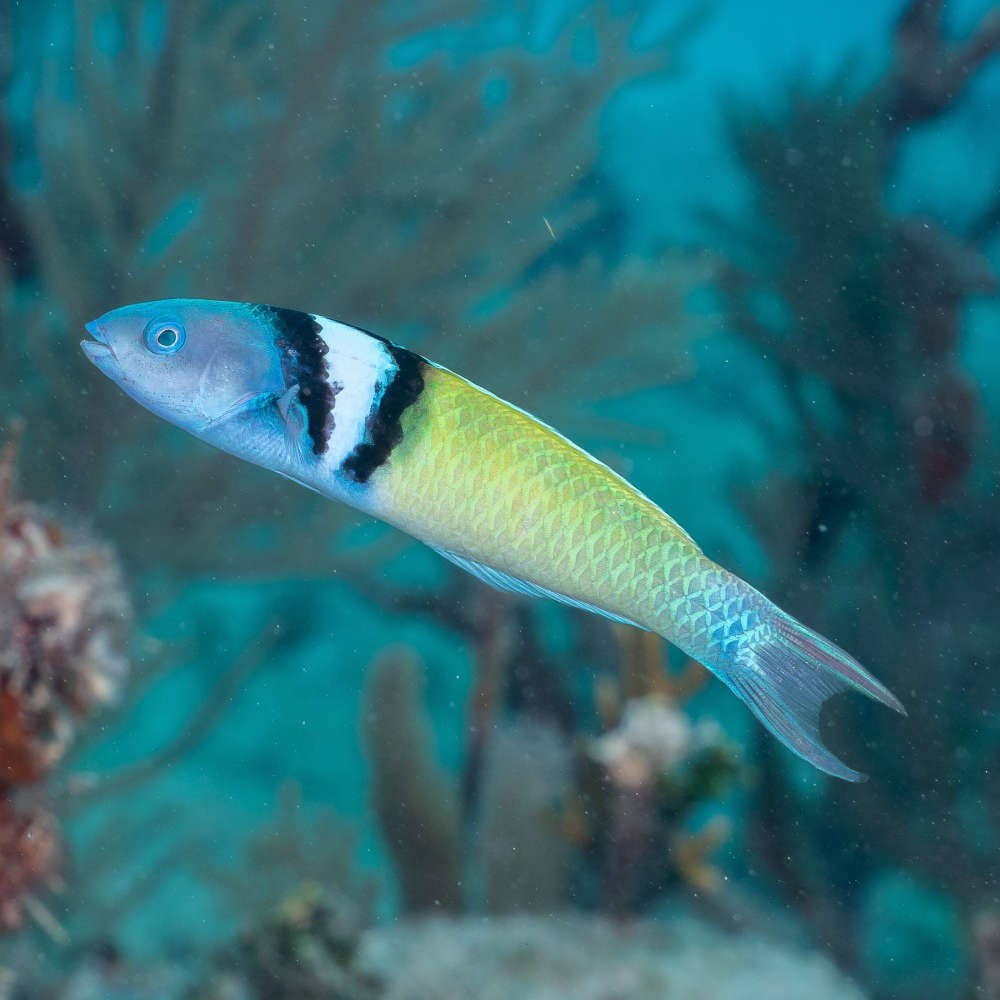
- Common Names: Tikitiki, doctor fish, parrotfish, bluehead, bluehead mah
- Average Size: Up to 25 cm (9.8 in)
- Average Lifespan: Up to 3 years
- Tank Level: All levels
- Temperament: Aggressive, territorial
- Diet: Carnivorous
- Reef Safe: Yes, but with caution
- Tank Mates: Own school, other aggressive species
- Minimum Tank Size: 75 gallons
The bluehead wrasse is elongated and slightly laterally compressed. Coloration varies throughout life stages.
While the juvenile fish has yellow coloring with a black side stripe, it fades with age.
Above the stripe, coral reef-dwelling specimens are yellow-colored, while non-reef species are white.
Females and small males have irregular blotches instead of a continuous stripe, with variations including a yellow head and upper body or a yellowish to greenish-blue upper body.
A supermale fish sports green to blue-green bodies, with two black bars surrounding a white stripe separating its blue, scaleless head. The caudal fin has black lobes, and the pectoral fins have black edges.
Being a protogynous hermaphrodite, it starts as a female and can change into a male as it matures.
This species swims mainly with its pectoral fin, unlike other fishes.
10. Mystery Wrasse (Pseudocheilinus ocellatus)
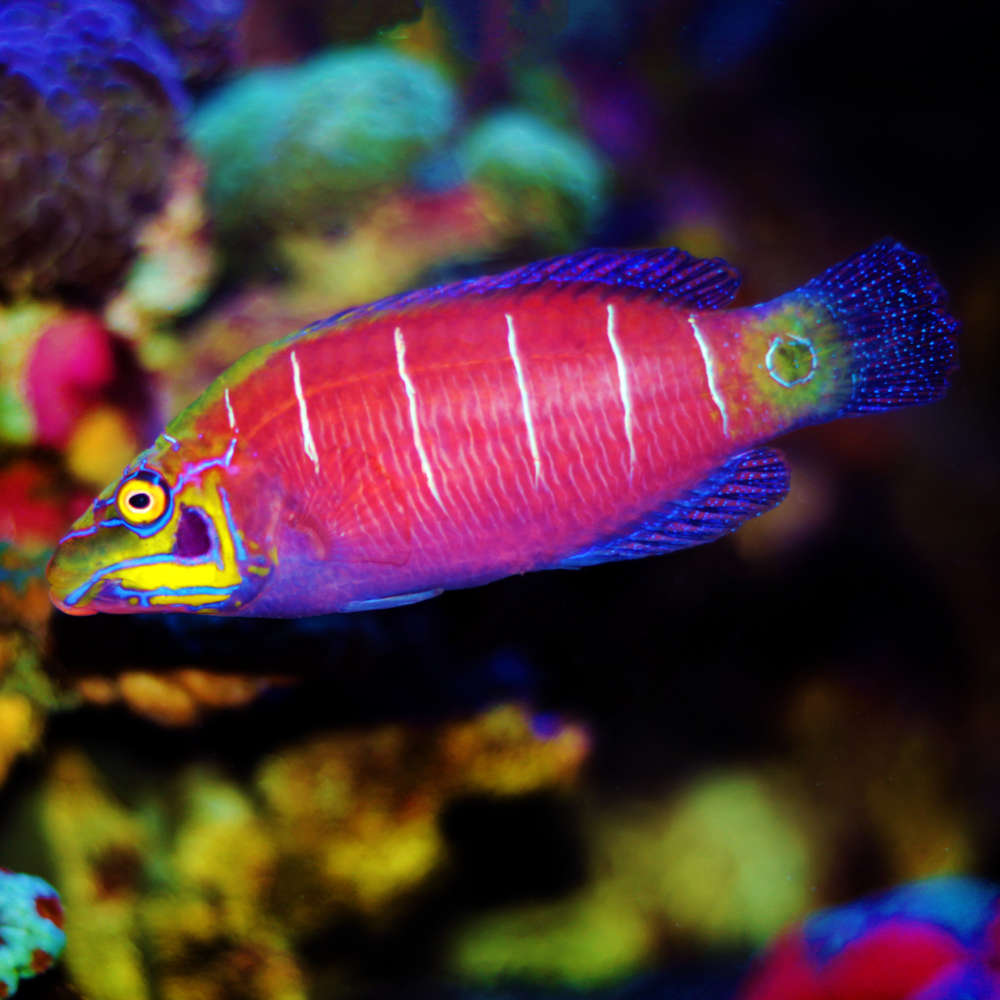
- Common Names: Whitebarred pink wrasse, white barred wrasse
- Average Size: 12 cm (4.7 in)
- Lifespan: Up to 5 years
- Tank Level: All levels
- Temperament: Semi-aggressive
- Diet: Carnivorous
- Reef Safe: Yes; requires caution
- Tank Mates: Semi-aggressive, larger, or slightly less aggressive non-wrasse species
- Minimum Tank Size: 75 gallons or larger
The mystery wrasse has a vibrant reddish-pink body adorned with five slender white vertical lines. These lines run from just behind the dorsal fin down about three-fourths of its body length.
As the wrasse matures, these lines may become thinner and, in some cases, even fade. There is a distinctive eye spot (ocellus) on each side near the tail, sometimes encircled by a yellowish hue.
Its head features a yellow coloration from the gills to the nose, marked by irregular, thin purplish-red lines. The fins are transparent with a hint of purple to burgundy coloring.
When these wrasses are juveniles, they resemble adults but have orange vertical lines instead of white, and their head is yellow-green with delicate orange and blue stripes.
It’s a protogynous hermaphrodite, thus always born female. However, it can transition to males depending on environmental factors.
They build mucous nets or cocoons while sleeping. So, in captivity, enough water current is necessary to prevent them from suffocating.
11. Red Coris Wrasse (Coris gaimard)
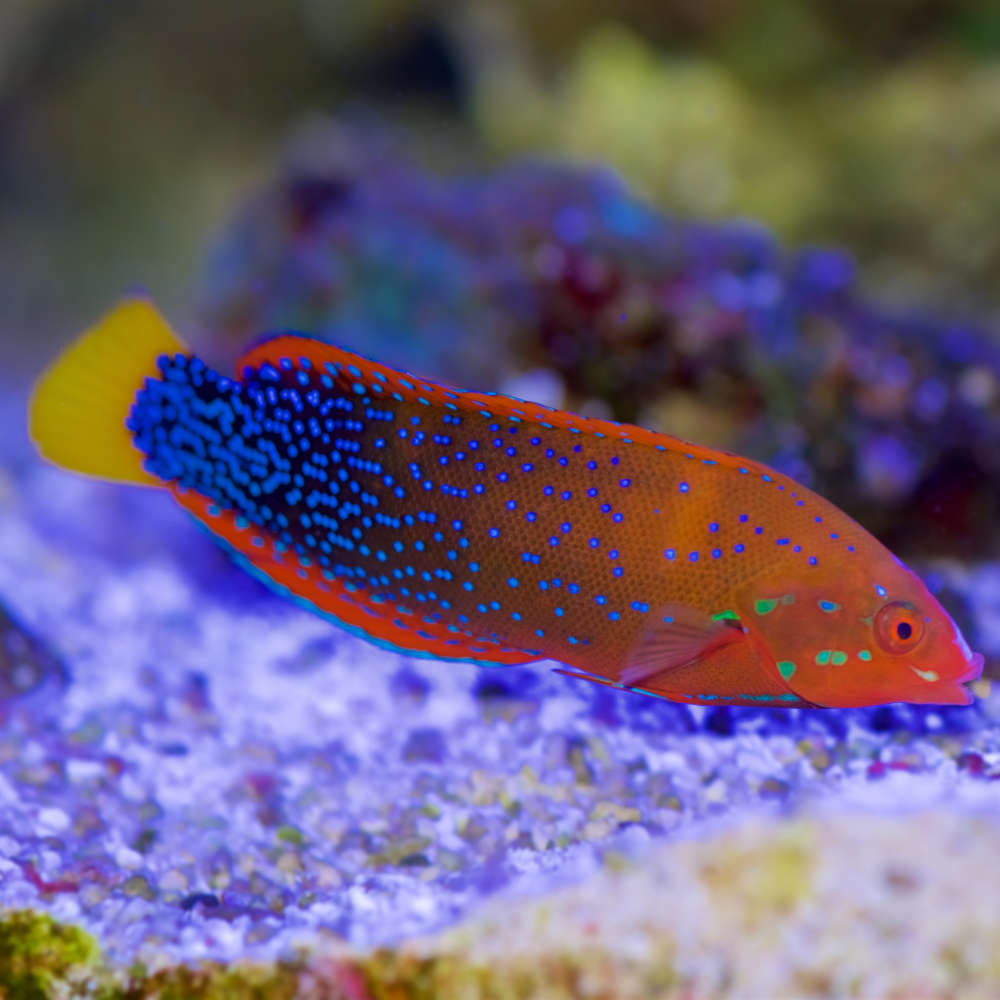
- Common Names: Yellowtail coris, tuskfish, wrasse, grimard’s wrasse, red-finned rainbowfish, clown wrasse, gimard rainbow wrasse, African coris, African clown coris
- Average Size: Usually up to 30 cm (12 in); Max: 40 cm (16 in)
- Average Lifespan: Up to 5-8 years
- Tank Level: All levels
- Temperament: Peaceful when young; Territorial and destructive as adults
- Diet: Carnivorous
- Reef Safe: No
- Tank Mates: Other energetic, bold, and aggressive non-wrasse species
- Minimum Tank Size: 125 gallons
The red coris wrasse possesses a slender, elongated body that enables it to swiftly and efficiently pursue preferred prey. Its tusk-like teeth help the fish reach into crevices and caves and also grasp prey.
When young, it appears as small reddish-orange fish with white spots outlined in black running along their backs.
As it matures, the red scales transform into green and orange stripes, the fins change to blue and red, and the tail becomes prominently yellow. The initial white and black spots gradually disappear.
The adult male adopts a dark gray hue with a green stripe behind the gills. It is usually slightly larger and more vividly colored than the female. The female has a bluish appearance with a red edge.
They like to hide themselves when stressed.
12. Bird Wrasse (Gomphosus varius)
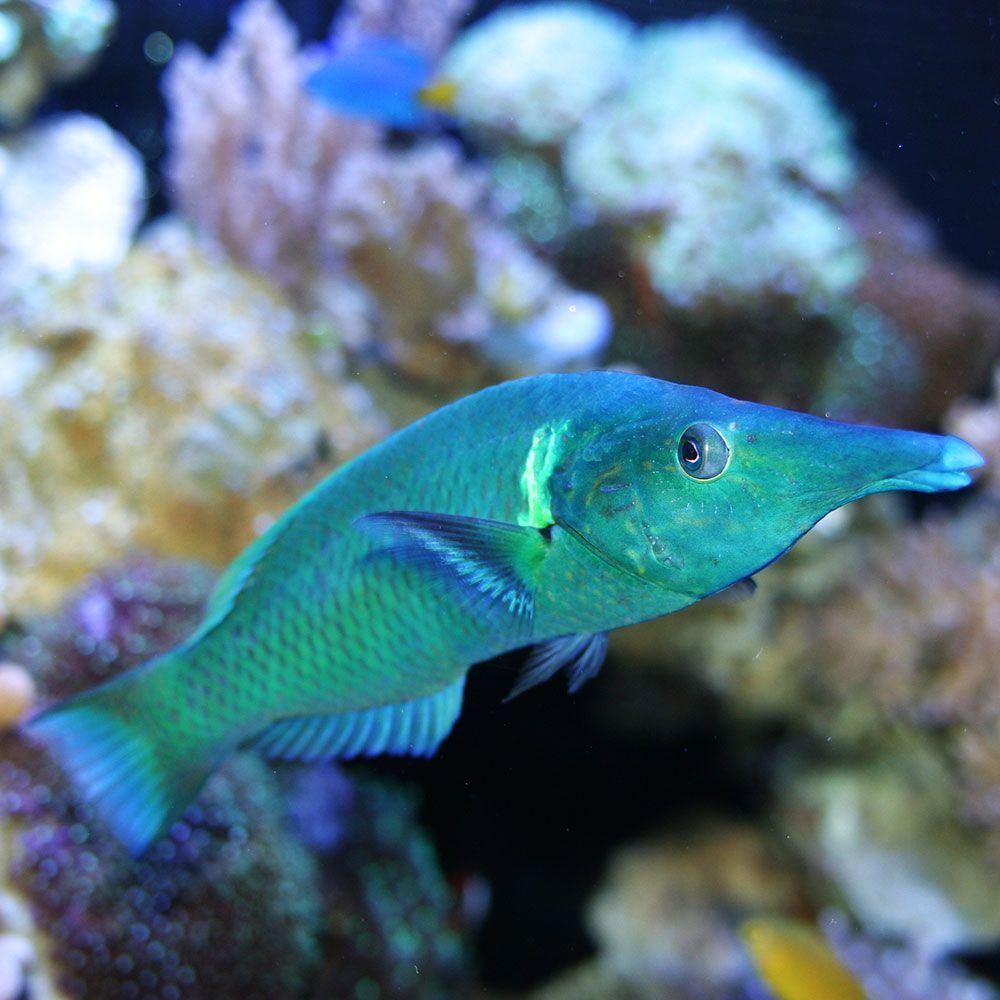
- Common Names: Pacific bird wrasse, purple club-nosed wrasse, green birdmouth wrasse, olive club-nosed wrasse, club-nosed wrasse, bird nose wrasse, brown bird wrasse
- Average Size: 30 cm (12 in)
- Average Lifespan: In captivity 3-5 years
- Tank Level: All with preference for bottom levels
- Temperament: Semi-aggressive
- Diet: Carnivorous
- Reef Safe: Yes
- Tank Mates: Own species, semi-aggressive or aggressive species
- Minimum Tank Size: 125 gallons
The bird wrasse is known for its elongated body and a beak-like snout. The fish has triangular pectoral fins that contribute to unique fluttering swimming motion.
It exhibits synchronous protogynous hermaphroditism. It’s born as female and can later transition into male.
Males, known as green bird wrasse, boast an emerald green coloration and are larger.
While females, referred to as black bird wrasse or brown bird wrasse, have a white body adorned with delicate black spots. This tends to become darker towards the rear of the fish.
The juveniles do not have a completely developed elongated beak. So, if you are looking for that snout, you probably need to stick to adults.
A word from FishInAquarium
There is a wide variety of wrasse species waiting out there to join your marine aquarium.
Whether you want to splurge big bucks or small, want a community tank or a species-only tank, or have a particular preference for color, these species will never let you down!
Though all the species have unique care requirements, they’re overall hardy and low-maintenance. Thus, wrasses are loved both by beginners and experienced aquarists!
So, if you’re ready to add a splash of color, start looking for the perfect one for you now!
That said, if you’re impressed with this interesting list, make sure to share it with your buddies. Share the joy of getting wrasses with other enthusiasts.
And if you guys walk into any trouble, don’t forget to email us, and we’ll guide you through!

